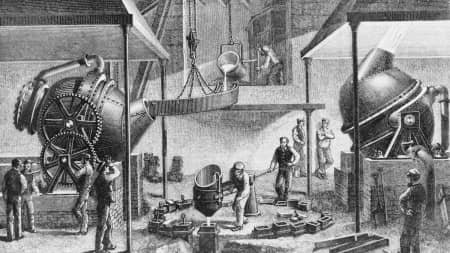The Bessemer Process: What It Is and How It Changed History
While you may not know what the Bessemer Process is, every single person has benefited from its invention and discovery. The process that allowed for the mass production of steel, the solidification of the Bessemer Process is the turning point in history that set the stage for mass development and growth. In fact, it is the process that may have single-handedly allowed for the industrial revolution.
What Is the Bessemer Process?
The Bessemer Process was the first inexpensive industrial process that allowed for the mass production of steel. Before the development of an open-mouth furnace, the process used a molten pig iron to melt iron. The real difference with this process was that air was forced through the molten iron to remove impurities.
Iron would be added to the molten pig and melted down to a bubbling point. By blowing oxygen in with the molten iron, any impurities would oxidize and separate. These impurities include silicon, manganese and carbon which would then escape the pig iron as a gas or solidify into a slag. Slag simply means by-product left over after a metal has been separated from the ore. Since steel is smelted from iron, these impurities are what is separated in the iron to unveil pure steel for production use.
Who Invented the Bessemer Process?
The Bessemer Process was named after its discoverer – Sir Henry Bessemer. He was an English man born in 1813. The first patent for the process was taken out in 1856. There are some controversial arguments that a different man invented the process. A William Kelly of the United States did patent the same type of discovery but the date was a few years after Bessemer. Today, Sir Henry Bessemer is still widely accepted as the inventor and first inventor of the process.
How The Bessemer Process Changed the World?
There are very few things in history that you can genuinely say changed the world. The Bessemer Process is one of them.
The biggest way that the Bessemer Process changed the world was by making steel cost-effective and mass-producible. Steel became a dominant construction material solely because of this invention. In England, the cost of steel dropped from £40 GBP to £6-7 GBP per long ton.
The Bessemer Process and the Industrial Revolution
The Industry Revolution is referred to as the move from the Iron Age to the Age of Steel. Once steel became cheaper and easy to mass-produce, stronger rails for railroads were able to be built. The United States, among other countries, could lay railways like never before. Steel rails lasted ten-time longer than steel rails and could support longer trains with heavier loads.
Railroads revolutionized the transportation of both people and goods. It changed the world – and economies – forever.
While railroads are one of the key ways that the Bessemer Process changed the world, one of the other ways was through the possibility of skyscrapers.
The Bessemer Process and Skyscrapers
Iron was absolutely necessary for the production of skyscrapers. In order to survive years against rain and snow while remaining stable against wind and storms, the traditional wood and brick structures just wouldn’t do it. More than that, getting enough beams to build a tall building would have taken too much time and money to even be worth it. As of the late 1800s, this was no longer the case. The iconic skyscrapers, skylines and awe that we associate to New York City, Chicago, LA and other mass urban areas would not have existed today without the Bessemer Process.
Moving Past the Bessemer Process
Knowledge of materials grew, scientific understanding advanced, and new smelting processes were discovered, The Bessemer Process became obsolete. The method stopped being used in the US completely in 1968. Electric air furnaces and other more technical oxygen steelmaking processes took its place.
Even though the Bessemer Process has no place in modern-day construction material production it laid the foundation for development as we know it.

